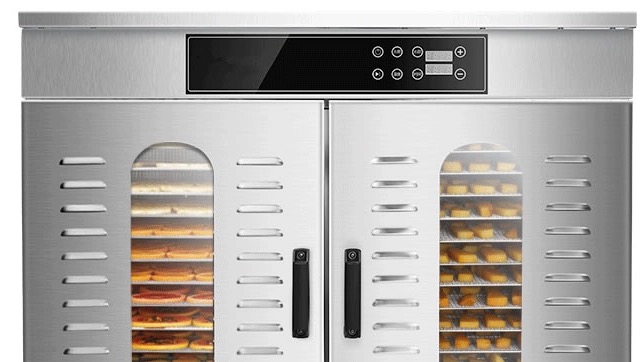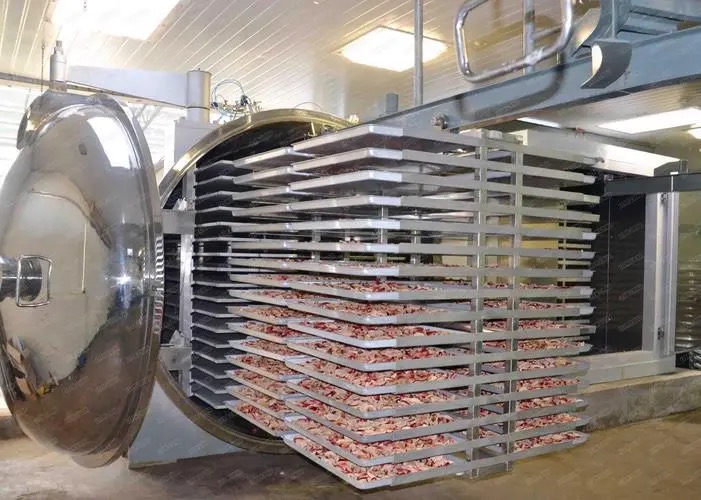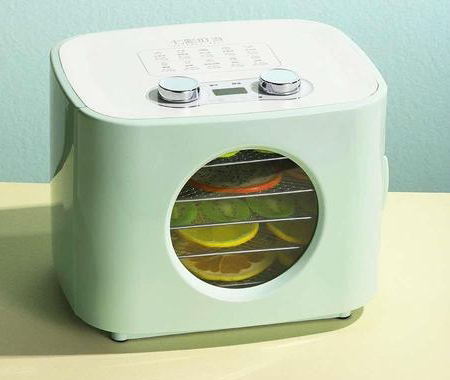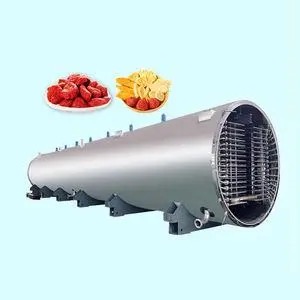
Content Menu
● Introduction to Fruit Dryer Machines in Malaysia
● Understanding Fruit Dryer Machines
>> How Fruit Dryer Machines Work
● Types of Fruit Dryer Machines Available in Malaysia
>> 1. Home Fruit Drying Machines
>> 2. Commercial Fruit Dryers
>> 3. Industrial Vegetable Dehydrators
>> 4. Multi-layer Fruit Dehydrators
● Features to Look for in a Fruit Dryer Machine
>> 1. Stainless Steel Construction
>> 2. Digital Controls
>> 3. Energy Efficiency
>> 4. Adjustable Trays
● Benefits of Using Fruit Dryer Machines in Malaysia
>> 1. Extended Shelf Life
>> 2. Preservation of Nutrients
>> 3. Space-Saving Storage
>> 4. Economic Opportunities
● Popular Fruits for Drying in Malaysia
● The Impact of Fruit Dryer Machines on Malaysian Agriculture
>> 1. Reduced Post-Harvest Losses
>> 2. Value Addition
>> 3. Export Opportunities
>> 4. Diversification of Products
● Choosing the Right Fruit Dryer Machine for Your Needs
● Maintenance and Care of Fruit Dryer Machines
● The Future of Fruit Drying in Malaysia
● Conclusion
● Frequently Asked Questions
>> 1. What is the best temperature for drying fruits in a fruit dryer machine?
>> 2. How long does it take to dry fruits in a fruit dryer machine?
>> 3. Are fruit dryer machines energy-efficient?
>> 4. Can I dry different types of fruits together in a fruit dryer machine?
>> 5. How long do dried fruits last when stored properly?
Introduction to Fruit Dryer Machines in Malaysia
Malaysia, with its tropical climate and abundant fruit harvests, has seen a growing interest in fruit dryer machines. These innovative appliances have revolutionized the way Malaysians preserve their favorite fruits, offering a convenient and efficient method to extend the shelf life of nature's sweet treats. In this comprehensive guide, we'll explore the world of fruit dryer machines in Malaysia, from their benefits and types to their impact on local food production and economy.
Understanding Fruit Dryer Machines
A fruit dryer machine, also known as a food dehydrator, is a device designed to remove moisture from fruits, vegetables, and other food items. This process helps preserve the food by inhibiting the growth of bacteria and mold, which typically thrive in moist environments. In Malaysia, where tropical fruits are abundant, these machines have become increasingly popular among households and businesses alike.
How Fruit Dryer Machines Work
Fruit dryer machines operate on a simple principle: they circulate warm air around the food items, gradually removing moisture. Most models feature multiple trays or layers, allowing users to dry different types of fruits simultaneously. The process can take anywhere from a few hours to a day, depending on the fruit's water content and the desired level of dryness.

Types of Fruit Dryer Machines Available in Malaysia
The Malaysian market offers a variety of fruit dryer machines to suit different needs and budgets. Let's explore some of the most popular types:
1. Home Fruit Drying Machines
These compact units are perfect for Malaysian households looking to preserve small batches of fruits. They typically feature 5-10 trays and are ideal for drying mangoes, pineapples, and other local favorites.
2. Commercial Fruit Dryers
Designed for small businesses and larger households, commercial fruit dryers offer increased capacity and faster drying times. They're popular among Malaysian entrepreneurs venturing into the dried fruit market.
3. Industrial Vegetable Dehydrators
While primarily designed for vegetables, these large-scale machines are also excellent for drying fruits in bulk. They're commonly used in Malaysian food processing plants and export-oriented businesses.
4. Multi-layer Fruit Dehydrators
These versatile machines offer multiple layers for drying different types of fruits simultaneously. They're popular among Malaysian fruit farmers and small-scale producers.
Features to Look for in a Fruit Dryer Machine
When choosing a fruit dryer machine in Malaysia, consider the following features:
1. Stainless Steel Construction
Opt for a stainless steel food dryer, as it offers durability and easy cleaning – essential in Malaysia's humid climate.
2. Digital Controls
A digital food dehydrator with precise temperature and time settings allows for better control over the drying process, ensuring consistent results.
3. Energy Efficiency
Look for an energy-efficient fruit dryer to keep electricity costs down, especially important for long drying sessions common in tropical fruit preservation.
4. Adjustable Trays
Machines with adjustable or removable trays offer flexibility in drying fruits of different sizes, from small berries to large mango slices.

Benefits of Using Fruit Dryer Machines in Malaysia
The adoption of fruit dryer machines in Malaysia has brought numerous benefits to both consumers and producers:
1. Extended Shelf Life
By removing moisture, fruit dryer machines significantly extend the shelf life of tropical fruits, reducing waste and allowing Malaysians to enjoy their favorite fruits year-round.
2. Preservation of Nutrients
Unlike some preservation methods, fruit drying retains most of the fruit's original nutrients, making dried fruits a healthy snack option for health-conscious Malaysians.
3. Space-Saving Storage
Dried fruits take up less space than fresh ones, making them ideal for Malaysian households with limited storage.
4. Economic Opportunities
The rise of fruit dryer machines has created new business opportunities in Malaysia, from small-scale dried fruit production to larger export-oriented operations.
Popular Fruits for Drying in Malaysia
Malaysia's tropical climate provides an abundance of fruits suitable for drying. Some popular choices include:
1. Mangoes
2. Pineapples
3. Papayas
4. Jackfruit
5. Durian (for the adventurous!)
6. Bananas
7. Rambutan
8. Lychee
The Impact of Fruit Dryer Machines on Malaysian Agriculture
The introduction of fruit dryer machines has had a significant impact on Malaysian agriculture and food production:
1. Reduced Post-Harvest Losses
Fruit dryers help farmers and producers minimize losses due to spoilage, especially during peak harvest seasons.
2. Value Addition
By transforming fresh fruits into dried products, Malaysian farmers can add value to their crops and potentially increase their income.
3. Export Opportunities
Dried fruits have a longer shelf life and are easier to transport, opening up new export markets for Malaysian fruit producers.
4. Diversification of Products
Fruit dryer machines allow for the creation of new products, such as dried fruit snacks and ingredients for the food industry, diversifying Malaysia's agricultural output.
Choosing the Right Fruit Dryer Machine for Your Needs
When selecting a fruit dryer machine in Malaysia, consider the following factors:
1. Capacity: Determine how much fruit you plan to dry regularly.
2. Size: Ensure the machine fits in your available space.
3. Features: Look for adjustable temperature settings and timer functions.
4. Energy consumption: Check the machine's power rating to estimate running costs.
5. Brand reputation: Research reliable brands available in the Malaysian market.
Maintenance and Care of Fruit Dryer Machines
To ensure your fruit dryer machine lasts long in Malaysia's climate:
1. Clean the trays and interior after each use to prevent mold growth.
2. Store the machine in a dry place when not in use.
3. Regularly check and clean air vents to maintain proper airflow.
4. Follow the manufacturer's instructions for any specific maintenance requirements.
The Future of Fruit Drying in Malaysia
As awareness of food preservation techniques grows and the demand for healthy snacks increases, the future of fruit drying in Malaysia looks promising. We can expect to see:
1. More advanced, energy-efficient models entering the market.
2. Increased adoption of fruit dryer machines in both households and businesses.
3. Growth in the dried fruit export sector.
4. Innovation in dried fruit products catering to local and international tastes.
Conclusion
Fruit dryer machines have undoubtedly made their mark on Malaysia's food landscape. From preserving the bounty of tropical harvests to creating new economic opportunities, these devices have proven their worth. Whether you're a home user looking to reduce food waste or an entrepreneur eyeing the dried fruit market, investing in a quality fruit dryer machine could be a fruitful decision in Malaysia's vibrant agricultural scene.

Frequently Asked Questions
1. What is the best temperature for drying fruits in a fruit dryer machine?
Answer: The ideal temperature for drying fruits typically ranges between 52°C to 63°C (125°F to 145°F). However, this can vary depending on the type of fruit and its water content. It's best to consult your machine's manual or a fruit drying guide for specific recommendations.
2. How long does it take to dry fruits in a fruit dryer machine?
Answer: Drying times can vary greatly depending on the fruit type, its thickness, and the desired level of dryness. On average, it can take anywhere from 6 to 36 hours. For example, thin apple slices might take 6-8 hours, while thick mango slices could take up to 24 hours or more.
3. Are fruit dryer machines energy-efficient?
Answer: Many modern fruit dryer machines are designed to be energy-efficient. While they do consume electricity over extended periods, they generally use less energy than conventional ovens. Look for models with energy-saving features and good insulation for the best efficiency.
4. Can I dry different types of fruits together in a fruit dryer machine?
Answer: Yes, you can dry different types of fruits together, but it's important to group fruits with similar drying times and moisture content. Also, be aware that flavors can sometimes transfer between fruits, so consider this when mixing strong-flavored fruits with milder ones.
5. How long do dried fruits last when stored properly?
Answer: When stored properly in airtight containers in a cool, dry place, most dried fruits can last for 6 to 12 months. Some fruits, like raisins, can even last up to 18 months. However, it's always best to check for any signs of spoilage before consuming stored dried fruits.












